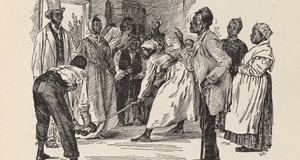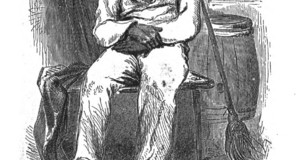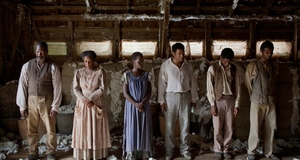Featured Article:The Uprisings of Nat Turner and John Brown: Response and Treatment from the Abolitionist Movement and the Press
By
2016, Vol. 8 No. 05 | pg. 1/3 | »
IN THIS ARTICLE
AbstractThis paper examines two influential slave uprisings and the treatment these received by both the abolitionist movement and the press. The first section explores the country’s reaction to John Brown’s raid on Harper’s Ferry, as well as his subsequent trial, conviction, and execution. The second section discusses the media coverage of and reaction to the Southampton Insurrection, the largest slave rebellion in the history of the United States. The third section explores the contrasting reactions to Nat Turner’s and John Brown’s respective revolts, and analyzes some of the reasons why these events received such differing responses. Ultimately, the paper explores a variety of potential reasons for the differing reactions to these two pivotal events, and the possible consequences of the actions, and inactions, of the abolitionist movement and the press. IntroductionThroughout the better part of the past year, I have endeavored to understand the differing, and ultimately converging, lives of two men--- Nat Turner and John Brown. I have lived with them, breathed their words and writing, in the hopes of arriving at the larger truth that lies within their eventual sacrifice. Although they were men who came from vastly different backgrounds, they somehow managed to arrive at the same conclusion: that slavery was an evil that had to be eradicated, and that their lives were a small enough price to pay for its defeat. I have also strived to understand the reaction of a nation which found itself utterly divided during this time period, and the ways in which Nat Turner’s and John Brown’s seminal events--- the Southampton Insurrection and the raid on Harper’s Ferry, respectively--- caused, or hastened, the dark clouds of Civil War which loomed large in the horizon. What I found is a world of newspapermen and abolitionists who were no less divided and conflicted than dictated by the zeitgeist in which they developed.I found a Southern press which struggled to comprehend Nat Turner’s ruinous attack, an abolitionist movement that was reluctant of putting its full weight behind a black man, and a Northern press that failed to capitalize on a golden opportunity to bring about change in the South. I found a great man--- John Hampden Pleasants--- who stood head and shoulders above the rest of his Southern brethren, reporting honestly and truthfully, not only the vicious acts of Nat Turner and his men, but also the equally brutal consequences of Southern vigilante actions which saw hundreds of Blacks summarily executed in the aftermath of the Southampton Insurrection. I found a glimmer of hope, winds of change in Virginia--- where thousands of men and women of all walks of life joined together in short-lived abolitionist sentiment. In William Lloyd Garrison, I discovered the great conflict of a gifted mind, still prisoner to a baseline of racism which deafened him to the faint whispers of change that echoed in the aftermath of Nat Turner’s rebellion. Later still, I saw an abolitionist movement that acted far too late--- in the aftermath of John Brown’s execution, when it did with him what it should have done with Nat Turner yet did not; a failure which may have indirectly caused the deaths of more than half a million people. A colorful and gripping scene evoking scenes from America's dark history of slavery is depicted in "Baltimore, My Baltimore," painting by Arvie Smith (2006). The first section, “Sic Semper Tyrannis,” explores the country’s reaction to John Brown’s raid on Harper’s Ferry, as well as his subsequent trial and execution. It deals with his supporters, who first deserted him and then rallied around him, championing his induction into the American pantheon. The second section, “A Horrible Ferocity,” discusses the media’s coverage of and reaction to the Southampton Insurrection, the largest slave rebellion in the history of the United States. It deals with John Hampden Pleasants’ work, a precursor to modern-day investigative journalism, and the many responses to his work which populated the columns of Northern newspapers, at a time when the North and South were not yet headed for certain war. The third section, “Humanity Will Out,” explores the contrasting reactions to Nat Turner’s and John Brown’s respective revolts, and strives to analyze the reasons why these events received such differing responses. It also examines the grassroots abolitionist movement which took hold of Virginia’s citizenry in the aftermath of the Southampton Insurrection, and the failure of the Northern abolitionist movement to support it, as well as the possible consequences of this inaction. Sic Semper TyrannisThe most famous image to emerge from Europe in the wake of the Harper’s Ferry raid was an engraving, titled simply John Brown.1 In it, the landscape is dark, the scene enveloped in shadows, and a human figure hangs from the gallows. Its features are almost completely obscured, blending masterfully with the cataclysmic scenery. From the heavens, a lone ray of light threatens to wash over the concealed figure, stopping just short of illuminating the figure’s face. Just above the scene, floating ethereally, a Latin inscription: Pro Christo Sicut Christus--- For Christ, Like Christ. Scribbled near the bottom of the piece: Ecce--- Behold.2 This engraving was the frontispiece to the most riveting piece of European commentary regarding John Brown’s execution, an open letter to the editors of the London News, authored by one of the most influential writers of the nineteenth century: Victor Hugo. Throughout the letter, Hugo offers a scathing commentary on the treatment of Brown by the Federal government. “The Champion of Christ,” he proclaims, “slaughtered by the American republic.” The letter prophesizes an eventual Civil War:
Victor Hugo’s letter was widely circulated by abolitionist publications across the North, and it soon became the crown jewel among the plentiful commentaries from overseas published by William Lloyd Garrison’s The Liberator throughout the winter following the execution of John Brown.4 To the bitterly divided nation, Hugo’s letter represented, fully and irrevocably, the opinion of the civilized world.5 On the same day Hugo was penning his letter; at a eulogy delivered in Cleveland, Ohio, Charles H. Langston, a prominent abolitionist who would become the first black man elected to the United States congress, declared the following: “I never thought that I should ever join in doing honor to or mourning any American white man.”6 Langston’s sentiment was shared by most throughout the African-American community. Many black-owned businesses across the North closed their doors in mourning on December 2nd, 1859, the day Brown was hanged. Thousands of people, white and black, gathered throughout the region to express their sorrow. Many wore black armbands, and members of several African-American churches resolved to dress in mourning for a period of thirty days. Members of the Second Baptist Church in Detroit collected twenty-five dollars for Brown’s widow, Mary, which is almost a thousand dollars in today’s money. In Ohio, where Brown spent long periods throughout his life, a crowd of fourteen hundred people gathered at Cleveland’s Melodeon Hall on the day of his execution. The venue was draped in black sheets, and his picture loomed large on a stage next to banners that quoted his final speech.7 Frederick Douglass, arguably the foremost black abolitionist and orator of the era, proclaimed Brown “one of the greatest heroes known to American fame.”8 Months before his eventual execution, the response to John Brown’s raid on Harper’s Ferry was almost as polarized within the confines of the abolitionist movement as it was in the South. The Liberator, perhaps the most influential anti-slavery publication of the era, called Brown’s raid a “misguided, wild, and apparently insane…but well intended” endeavor. Its editor, the abolitionist leader William Lloyd Garrison, highlighted his own personal opposition to violent activism, “even in the best of causes.” At the same time, he added that “no one who glories in the revolutionary struggle of 1776 could deny the rights of the slaves that imitate the example of our fathers.”9 The immediate reaction of the vast majority of abolitionist leaders, however, was much less ambiguous than that of Garrison. Fearing indictment, many supporters of Brown publicly denied any connection to the event, and decried Brown as a madman.10 Among the most anxious groups to distance themselves from Brown were the members of the mysterious “Secret Six,” a group of influential men who had secretly funded the raid. Of the six men, only Reverend Thomas Wentworth Higginson remained active following the incident. Four of them, in fact, immediately went into hiding or left the country altogether.11 Perhaps the most interesting response among the infamous six was that of Gerrit Smith, who was Elizabeth Cady Stanton’s first cousin. Immediately following the news of Brown’s raid, Smith was calm, and even considered writing editorials in support of Brown’s actions: Had he done this, he would have been the only abolitionist leader to publicly proclaim his support of Brown’s violent activism.12 However, within days of the event, Smith suffered a complete mental breakdown--- a product of revelations by the press regarding the extent of his relationship to Brown, as well as a motion for his arrest and execution by then-Senator Jefferson Davis.13 George Putnam, Smith’s close friend and confidant, wrote the following regarding his collapse: “He was at times sublime in his willingness to be offered up in defense of his principles & then filled with terror at the thought of the tortures which he fully believed would be practiced upon him when he reached the South & soon he was fixed in the belief he was a doomed man & that he could look from hour to hour for the officers who were to take him to the scene of torture & death.”14 It is clear from this passage that Smith’s mental collapse was not feigned, but rather a real consequence of the psychological toll that the battle against slavery claimed on those who chose to partake in it.15 The negative initial reactions of abolitionist Northerners quickly faded, and Brown’s financial backers gradually came out of hiding--- Gerrit Smith would discharge himself from the asylum he had voluntarily entered after a stay of about two months. Leaders within the anti-slavery community quickly realized that John Brown had the potential to be turned into the most remarkable martyr to their cause since Elijah P. Lovejoy’s brutal murder at the hands of a deranged mob twenty-two years earlier. On the subject of Brown’s martyrdom, Henry Ward Beecher--- an influential clergyman and anti-slavery advocate--- said the following: “Let no man pray that Brown be spared. Let Virginia make him a martyr! Now, he has only blundered…But a cord and gibbet would redeem all that, and round up Brown’s failure with a heroic success.”16 Garrison himself stated, even before he was sentenced by the court, that “of course, he will be hung,” and although he qualified his statement by declaring Brown’s impending execution “a terrible losing day for all Slavedom,” he quite clearly believed that his death would provide a great opportunity for the abolitionist movement.17 Indeed, this argument is further proven true by Garrison’s crass assertion, made two weeks after the execution, that “John Brown executed will do more good for our cause, incomparably, than John Brown pardoned.”18 As much as a careful study of the available sources may reveal a political decision by abolitionist leaders to preemptively martyrize Brown at the expense of justice, we cannot discount the part that Brown himself played in this surfacing dynamic. He was, by all accounts, the greatest and most persuasive advocate of his own fate. However, Brown’s own response to his failed raid, trial, and subsequent conviction cannot be considered unrelated to that of the anti-slavery community. Brown was very much aware of the kind of eternal life that William Lloyd Garrison, Henry Ward Beecher, and many others like them throughout the nation envisioned for him.19 For someone whose life had been greatly marked by personal failure, this promise of immortality was perhaps very tempting.20 As a matter of fact, there is quite possibly no greater blunder throughout this entire process--- on either side of the Mason-Dixon line--- than Virginia Governor Henry Wise’s decision to allow Brown to have visitors, as well as send and receive correspondence while in jail. This simple act of mercy allowed Brown to transform the world into a podium from which to justify his crusade to the nation: throughout the six weeks that Brown spent in jail, he was visited by as many as eight-hundred people, and wrote hundreds of letters.21 He was privy to virtually every piece of news, writing and rhetoric that the North was producing. An extremely religious man, there can be little doubt that Brown read the myriad comparisons being made throughout the North between him and Jesus of Nazareth. Ralph Waldo Emerson, for example, declared that Brown “would make the gallows as glorious as the cross.”22 Statements like Emerson’s were bountiful in the weeks Brown was in jail, and he responded accordingly: when his friend Samuel Pomeroy--- who had fought with him in Kansas--- visited him, Brown greeted him by saying “in prison ye come unto me,” thus directly quoting Jesus from the Bible.23 When Pomeroy proposed a rescue plan, Brown immediately declined, telling him the same thing he had told his brother: “I am worth now infinitely more to die than to live.”24 The way in which Brown had come to see himself was made even more obvious in some of the letters he wrote from jail. In a letter to “E.B.,” Brown says: “You know that Christ once armed Peter. So also in my case I think he put a sword into my hand.”25 Truthfully, the extent to which Brown was influenced by the foresight of his supporters cannot be measured empirically. However, it would be naïve to argue that the abolitionist community’s actions did not directly inform Brown’s performance--- for there is no better term for it--- throughout the final weeks of his life. The months following the execution of John Brown saw an almost immediate effort to exploit the death of the newly minter martyr.26 Truly no metaphor, whether historical, mythological, or religious, was so strained that it could not be used to describe his actions. Indeed, Brown was equated to figures as varied as Moses, Joshua, Hercules, John the Baptist, Spartacus, Ignatius Loyola, George Washington, Garibaldi, Socrates, Galileo, and, as mentioned before, Jesus of Nazareth.27 Among the many voices who likened Brown to Jesus, it was arguably Henry David Thoreau who most unambiguously connected the two, writing on the day of Brown’s death: “Some eighteen hundred years ago Christ was crucified; this morning, perchance, Captain Brown was hanged. These are two ends of a chain which is not without its links. He is not Old Brown any longer; he is an angel of light.”28 Aside from the religious overtones adopted by many abolitionist leaders, many of Brown’s supporters sought to justify his violent methods with a variety of moral principles and historical precedents. Of course, it was none other than the Founding Fathers who supplied the necessary ammunition to wholly justify Brown’s violence:
The Declaration of Independence was not the only powerful document used to justify Brown’s violence. Ironically, as The Liberator gleefully noted in an article written by Garrison, further ammunition could be found within the very seal of Virginia: “The seal represents LIBERTY armed cap-a-pic, with her foot upon the neck of the tyrant, having cut off his head with her sword, and exclaiming, ‘sic semper tyrannis’--- SO BE IT EVER TO TYRANTS.”29 Lastly, there was the belief among many abolitionists that John Brown’s actions at Harper’s Ferry had made the prospect of civil war inevitable. Of course, John Brown himself echoed this belief with his famous last words, when he declared: “I, John Brown, am now quite certain that the crimes of this land can never be purged away but with blood.”30 Brown’s attempted insurrection did, in fact, vastly increase the amount of Northerners who accepted militant action as a legitimate means to fight slavery. William Lloyd Garrison himself had been, throughout his entire life, heavily against violent action in the name of abolition; however, in the wake of Brown’s execution, he abandoned his policy of nonviolence.31 In the end, it was Wendell Phillips--- one of Brown’s more notorious financial backers--- who best summed up the overarching response to John Brown’s raid and execution. At Brown’s funeral oration, he said: “Insurrection was a harsh, horrible word to millions only a month ago.”32 Perhaps, indeed, John Brown died for our sins; but he would not be the only one. Only six years later, over half a million people shared his grave.Continued on Next Page » Suggested Reading from Inquiries Journal
Inquiries Journal provides undergraduate and graduate students around the world a platform for the wide dissemination of academic work over a range of core disciplines. Representing the work of students from hundreds of institutions around the globe, Inquiries Journal's large database of academic articles is completely free. Learn more | Blog | Submit Latest in History |



















